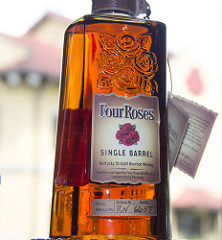 As scotch whisky prices creep upward, I’ve been dabbling in the world of bourbons and other domestically produced whiskies. There’s a whole rich world of spirits here, a rapidly growing craft distilling culture, so why limit myself? I’m sure you’d all agree… whisky is good, whether it has an E in it or not! 🙂
As scotch whisky prices creep upward, I’ve been dabbling in the world of bourbons and other domestically produced whiskies. There’s a whole rich world of spirits here, a rapidly growing craft distilling culture, so why limit myself? I’m sure you’d all agree… whisky is good, whether it has an E in it or not! 🙂
On a recent trip state-side, my friend Rick asked me to pick up a bottle of Four Roses Single Barrel because he’d heard it was good and it wasn’t available in the UK. I decided that if it was good enough that he wanted me to pick one up for him when he came by, it was certainly going to be good enough for me to buy for myself… the logic is sound, right? And at just $43 a bottle at the local store, it was hardly a big bet.
This wasn’t my first meeting with Four Roses. I’d tried their Small batch, Single Barrel, and Yellow Bourbon back in May of 2011. Back then, I didn’t have the experience, vocabulary, or the palate to appreciate a 100 proof bourbon.
Fast forward five years, a lot of drams, and you bet I can appreciate it now!
The label of my Four Roses Single Barrel stated it was from Warehouse No. TS, Barrel No. 41-6E, for what that’s worth, and I suspect there will be small variations between all the single barrels from different barrels.
Tasting Notes
- Nose: Cherry, plum, vanilla, maple syrup
- Taste: Big red chewing gum (i.e. cinnamon), sweet
- Finish: Medium, spicy
In my mind, they could’ve replaced the Four Roses logo with four cherries, that’s how pronounced that flavor was on both the nose and the palate. Cherry was the high note flavor while plum and vanilla rounded it out. Cinnamon presented itself like the chewing gum Big Red, it was unreal because that was my first thought and it’s been 20+ years since I’ve smelled or chewed that gum, and there was a sweetness ever present. Finish was nice, a little heat and spice, but complemented the cherries, vanilla, and cinnamon.
I wonder how much of the fun of this bottle was in the nostalgia of a gum I haven’t chewed in many years. I wasn’t even a big fan of Big Red too, I preferred spearmint gums over different flavored ones. But when I did get a stick of Big Red, the novelty was always fun and it reminded me of all the fun I had in the first few minutes of a Fireball (after the spice was gone, I usually spit those out!).
Thoroughly enjoyed it, would get again. 🙂
